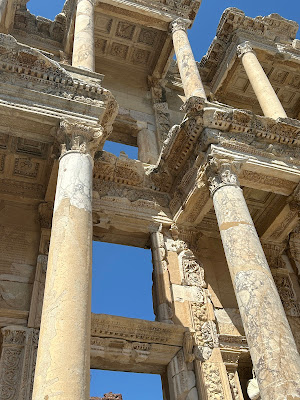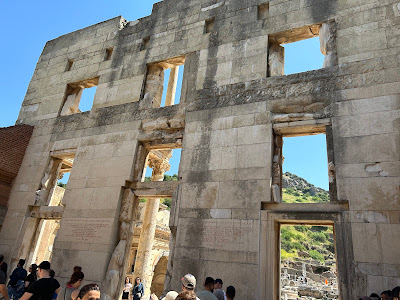The Library of Celsus, located in Ephesus, is one of the most recognizable archaeological structures I would bet most people could not put a name to.
It was commissioned in A.D. 110 by Tiberius Julius Aquila Polemaeanus, a consul of the Roman Empire, in memory of his father Tiberius Julius Celsus Polemaeanus and former proconsul of Asia (you will remember from last week that Ephesus had become the capital of the Roman province of Asia). It was both a library and a tomb; Celsus was buried beneath it, a signal honor as it was almost never done in Rome.
It was considered the third largest library in the ancient world behind those of Alexandria and Pergamon, with an estimated 12,000 scrolls
At the front of the Library were four female statues, personifications of virtues: Sophia (Wisdom), Epistime (Knowledge), Ennoia (Intelligence), and Arete (Excellence). The current statues are not the originals.
Inside the library were a total of three levels of bookcases, to be accessed by stairways. On each level were armaria, niches where the scrolls were placed.
The library burned in A.D. 262 due to unknown reasons. The faced itself collapsed in an earthquake in the 10th or 11th century, where it remained until the 1970's, when the site was restored.
The Gate of Augustus, to the left of the Library of Celsus as you exit. Built to honor Augustus Caesar and his family.
Through the Gate of Augustus lies the Agora, the marketplace of Ephesus. Its placement is not accidental; it lies close to the old harbor.
A typical market stall within the Agora. These are similar to what we saw in the Agora of Athens.
Looking back in the Agora towards The Gate of Augustus.
From the Agora, looking up to the Theater of Ephesus.
Looking back. To the right of the large building in the background is the location of the Library of Celsus.
If I recall correctly, this was considered part of the "red light district", conveniently placed near the Agora, the Theater, and the harbor. Or as we used to say in real estate, "location, location, location".
















Not very long ago, I learned quite a bit about the Romans and their scrolls in a television piece on the scrolls of Herculaneum which I think has the distinction of being the only surviving library of that age. Scientists are using modern science equipment to read the scrolls without having to unroll them since they were charred by the eruption of Mt. Vesuvius.
ReplyDeleteEd, I have been watching the developments of the scrolls of Herculaneum with great interest. The fact that they survived at all is a miracle, the fact it may with our technological grasp to read them is amazing. We went from reading one word in October of 2023 to getting full passages this year: https://www.cnn.com/2024/02/07/world/herculaneum-scroll-passages-decoded-philodemus-vesuvius-scn/index.html
DeleteDiognes Laertius' Volumes Lives of Eminent Philosophers lists so many known works of the Ancient World that simply do not exist. That combined with other historical works that we only have through references in existing works....if we can manage to not blow ourselves up, our knowledge of the Ancient World could change dramatically.
https://www.cnn.com/2024/02/07/world/herculaneum-scroll-passages-decoded-philodemus-vesuvius-scn/index.html
Man, the stonework, those columns.....and....."red light district"..."red light district" never changes (for fans of Fallout.....:).
ReplyDeleteNylon12, it is quite impressive. I am honestly quite grateful to the Turkish government for allowing this to be reconstructed. It really reveals the scope and magnificence of the Ancient World.
DeleteAnd yes, even in the Ancient Past and future gaming, Red Light districts remain the same...
What an impressive structure. It is currently being reconstructed? Must have been amazing it its time.
ReplyDeleteLeigh, it truly is impressive and gives a taste of what Rome and Ephesus might have looked like in all their glory.
DeleteThis reconstruction was done in the 1970's. I am not sure if there plans to continue with such a thing; times have changed in terms of rebuilding such things directly on the site they were at (as opposed to ensuring that it will continue to stand through strengthening structures; Turkey is prone to earthquakes). One wishes that that sometime, on the grounds, they might consider a reconstruction similar to what The American Archaeological School did in Athens with the Stoa of Attalos.